Suhru Blog
History of the Grape: La Crescent
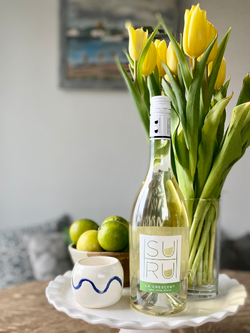 We are proud to announce the release of Suhru Wines's 2022 La Crescent, released March 15, 2023, the first La Crescent produced on Long Island. The launch of this wine marks Assistant Winemaker Brad Ulrich's debut as a winemaker and a very promising start to his career. “I was drawn in by the flavor. This varietal has very strong citrus notes and a fruity aroma. After using it in blending for Suhru’s 2021 Rosé I believed it could be made into a very nice stand alone wine.”
We are proud to announce the release of Suhru Wines's 2022 La Crescent, released March 15, 2023, the first La Crescent produced on Long Island. The launch of this wine marks Assistant Winemaker Brad Ulrich's debut as a winemaker and a very promising start to his career. “I was drawn in by the flavor. This varietal has very strong citrus notes and a fruity aroma. After using it in blending for Suhru’s 2021 Rosé I believed it could be made into a very nice stand alone wine.”
A Brief History of the Grape
A new wine varietal, La Crescent is a Hybrid variety developed at the University of Minnesota and released to the industry in 2002. The grape was named “La Crescent” (pronounced like crescent moon), after a town along the Mississippi River in Minnesota. It has shown strong promise and is well suited to the cool and cold climates of the Northeast. Its winter hardiness, vigor and climate adaptability make it a natural fit for a Sustainable minded winemaker.
This grape is often characterized by its fruitiness due to high levels of aromatic, phenolic compounds like terpenes. Known to have floral, fruit forward flavors, rich tropical and citrus notes, La Crescent is a descendant of Muscat. Another key characteristic of the grape is high acidity, making it well suited to a variety of winemaking styles.
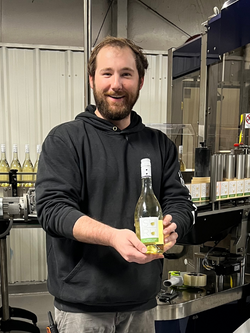
A Note from Assistant Winemaker Brad Ulrich
I am very excited to release our 2022 La Crescent. It is a variety that caught my attention during the 2020 and 2021 harvests and that I have been looking forward to working with more closely. One of the reasons I was so excited to work with La Crescent as a single variety wine, is because it is a new grape variety to the wine world; there are very few examples and no real road map to follow. There are only a handful of other La Crescent wines out there that are currently being produced. Because it is such an “unknown” grape it allowed us the freedom to get creative in the winery and experiment with a number of winemaking techniques and blending options to accentuate the natural citrus flavors of the varietal.
A Closer Look at Suhru La Crescent
The release of our 2022 La Crescent marks the start of a new collection of Suhru Wines, designed to highlight some of the lesser known grape varietals being grown across New York State. Gone are the days when wine lovers only reach for the classic European grape varieties. As evident by the success of our Teroldego, which we first produced in 2019. Wine enthusiasts are excited by and interested in trying something new. “We are finding this particularly true with the younger generation of wine drinkers, making it the perfect grape for Assistant Winemaker Brad Ulrich debut wine, as he continues to express and define his personal winemaking style,” said winemaker Russell Hearn.
A refreshing, bright, approachable wine with dynamic fruit notes and a big burst of flavor. This easy drinking white is light bodied with a soft, refreshing finish and a touch of sweetness.
Learn More About La Crescent
History of the Grape: Merlot
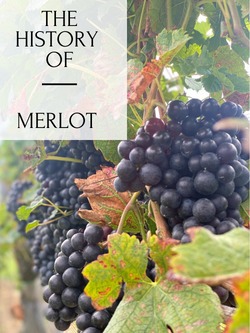 One of the world's most popular red wines—Merlot is loved for its versatility! Here on the North Fork of Long Island it is one of the most prolific and widely planted varieties. A consistent ripener, Merlot makes beautiful blends as well as single varietal wines.
One of the world's most popular red wines—Merlot is loved for its versatility! Here on the North Fork of Long Island it is one of the most prolific and widely planted varieties. A consistent ripener, Merlot makes beautiful blends as well as single varietal wines.
Although currently one of the most popular wines in the world, Merlot was originally considered a secondary grape by winemakers, believed to be best suited for blending rather than as a “stand alone” varietal. While there are now a plethora of delicious single varietal Merlot’s to choose from on the East End as well as around the globe, Merlot continues to be a favorite amongst winemakers when it comes to blending.
A Brief History of the Grape
Merlot was first mentioned in 1784, in Bordeaux. Back then it was called Merlau or Merle. It is said that Merlot was named after the “blackbirds” that loved to eat the ripe grapes, these birds were a similar blue, black color to the ripe grapes.
Still the most planted grape in Bordeaux France, Merlot grows alongside the other classic Bordeaux red varietals including Cabernet Sauvignon, Cabernet Franc, Malbec and Petit Verdot. In Italy, Merlot was originally called Bordo and is widely used as a blending grape in Super Tuscan wines.
Planted all over the world, Merlot grows well on sandy loam or well-drained soils that have good moisture holding capacity. Well suited to cool climate regions (think Long Island) Merlot ripens into dark blue to black berries with thin skins and loose, large bunches.
Fun Fact: the most expensive Merlot was sold at auction in 2011. A case of 1961 Petrus went for $144,000 USD which comes to $12,000 a bottle!
Merlot reached its peak popularity in the US in the 1990’s, then experienced a drop in popularity after the movie Sideways came out in which Paul Giammatti's character poked fun at the wine, saying Merlot is bland and the market is oversaturated with the varietal. In the two decades since, Merlot has made a comeback and is currently the second most popular grape varietal in the United States.
A Closer Look at our Merlot
Classic old-world style, our Merlot was released to the public on February 1, 2023 and is quickly becoming a crowd favorite! This old-world style red is a beautiful representation of North Fork Merlot. The staple of Long Island Wine Country, Merlot is wonderfully well suited to our cool, maritime climate with consistent ripening and excellent aging potential. A medium bodied wine with beautiful red fruit notes and hints of spice on the nose with red fruit flowing onto the palate. It is elegant with a light hint of vanilla and a seamless, silky finish.
Recommended Food Pairings
Like all reds, Merlot is best served at room temperature (60 – 65 degrees F). Medium to full-bodied reds in general are recommended to be served at a low 60 degrees Fahrenheit to best showcase the ripe fruit notes and soft tannins. Merlot pairs well with a variety of foods including white and dark meats from chicken, turkey and pork as well as pasta, burgers and pizza, cheese plates, beef stew and more.
Make sure to open your favorite bottle of Merlot and toast this versatile grape as you savor every sip!
Learn More About our Merlot
The Ageability of Suhru Reds
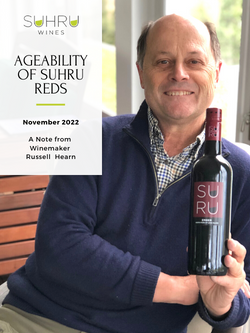 One of the things I love most about winemaking is the cyclical nature of the profession and its ties to nature. It is very rewarding each year watching the progression of the vine throughout the growing season moving from bud break in the Spring, to fruit set and cluster development over the Summer months, ripening and harvest in the Fall and then watching the vines go dormant for the Winter months before it all starts up again.
One of the things I love most about winemaking is the cyclical nature of the profession and its ties to nature. It is very rewarding each year watching the progression of the vine throughout the growing season moving from bud break in the Spring, to fruit set and cluster development over the Summer months, ripening and harvest in the Fall and then watching the vines go dormant for the Winter months before it all starts up again.
While Harvest and the vineyard tend to get most of the attention in the wine world, as a winemaker I also get to see what goes on behind the scenes in the tank, barrel and bottle. Much like the cyclical cycle of the growing season, the winery runs the same with the hustle and bustle of Harvest in the Fall with fermentation, racking, filtrations followed by barrel aging for our reds and the beginning of bottling of whites and rosés in the Winter Months moving into red blending trials and red bottling in the Spring and Summer before it all starts up again.
While the vineyard and winery work is often the most visible, there is a lot happening in the bottle as it continues to bottle age in the months, years, and decades after it is initially bottled. Which brings us to our Library wines. We are excited to be sharing a selection of Library Reds.
A Closer Look at the Long Island Wine Region
The Long Island Wine Region, specifically the North Fork is what is referred to as a Cool Climate growing region, meaning that we get "cool" not "cold" temperatures in the Winter months. While it may not always feel that way to us, and we do get inarguably very cold days, those extreme cold temperatures are moderated by our proximity to the ocean. Being surrounded by water on three sides, the water acts as a blanket in the cooler months insulating us from the extreme cold temperatures that you see in Northern wine regions such as the Finger Lakes. This allows us to grow vitis vinifera grape varietals and for the wines made from those grapes to retain higher acidity and moderate alcohols typically in the 13-13.5% range.
The Ageability of Suhru Reds
As a winemaker, my style preference of not trying to extract much of the astringent tannin from the seeds by shorter soak times during fermentation, creates softer red wines. That coupled with the fact that Long Island reds retain higher acidity and moderate alcohol levels, means that wines from our region can comfortably age in the bottle for 10-15 years. As we approach the end of 2022 this means that wines from the 2013 vintages, undisputedly one of the best growing years on Long Island, are quickly approaching their 10 year age mark.
The 2013 vintage was a near perfect growing season on the North Fork of Long Island, regarded as one of our region's best vintages to date. This was due to a hot, dry summer and absolutely zero rainfall during the entire Harvest, meaning every varietal was able to reach optimal growth and development unimpeded. We saw this trend of high quality vintages continue into 2014 and 2015 leading to excellent wine in the bottle.
We hope you will join us this weekend for our Library Reds Tasting, available by reservation Thursday, November 17th - Monday, November 21st. Can't make the event but still interested in exploring these delicious wines? Click Here.
Hand vs Mechanical Harvesting
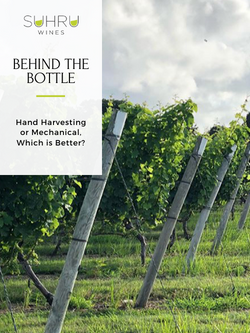 As you drive around the North Fork, you likely will see many teams out in the vineyard working to ensure the grapes ripen to their full potential throughout the growing season. While often an overlooked component of the winemaking process, good vineyard management is essential to good winemaking.
As you drive around the North Fork, you likely will see many teams out in the vineyard working to ensure the grapes ripen to their full potential throughout the growing season. While often an overlooked component of the winemaking process, good vineyard management is essential to good winemaking.
A wine is only as good as the grapes it comes from and good vineyard practices throughout the year mean less intervention and a more hands off approach can be taken by the winemaker and the winemaking team once the fruit arrives at the winery.
There are two main ways to harvest grapes, by hand and by machine. At Suhru, we hand harvest the majority of our grapes. The decision to hand harvest vs mechanical harvest depends on a multitude of factors including the grape varietal, condition of the grapes, and style of wine you are trying to make. Let's explore the differences!
 Mechanical Harvesting
Mechanical Harvesting
For many grape varieties and styles, particularly early ripening white wine grapes, mechanical harvesting is a more efficient and cost effective approach. In mechanical harvesting a harvester machine straddles the grape vine, gently shaking the vine which dislodges the berries dropping them into a conveyor belt that carries them to a holding bin. When the harvester reaches the end of the row the holding bin is emptied into a gondola which then transports the grapes to the winery to be loaded into the press.
Mechanical harvesters are a great option for larger vineyards that lay on flat level ground. They can very quickly harvest an entire block of fruit and get it to the winery and loaded into the press in a fraction of the time it would take to hand harvest the same block.
At Suhru we machine harvest our Pinot Grigio. The vineyard where it is grown is well suited to a mechanical harvester and it allows our early ripening Pinot Grigio berries to arrive at the winery very quickly after being harvested which is important for machine harvested fruit as the berries are often split open during the harvesting process.
 Hand Harvesting
Hand Harvesting
Hand harvesting, while extremely labor intensive, allows our vineyard team to examine the fruit as they move through the vineyard, selecting only the best grape clusters and discarding the bruised, damaged or underripe fruit. A skilled hand harvester can pick between one and one and a half tons of grapes in a 10 hour day, which is the equivalent of 800-1,200 bottles of wine or 66-100 cases.
While more expensive, laborious, and time consuming there are a number of reasons to hand harvest your grapes:
- Allows for more precision. The grapes are better protected during harvesting greatly reducing the possibility of oxidation due to damaged skins.
- Winemaking Style. For a number of styles including méthode champenoise and some styles of white wine we whole cluster press, meaning that the entire cluster, stems, seeds, skins and all are loaded into the press and discarded as one once the juice has been pressed out.
- Fruit quality. When you machine harvest all the berries are mixed in however when you hand harvest as the vineyard crew is moving from cluster to cluster they can pick out any berries damaged by birds or any that have not fully developed ensuring that only the best berries make it to the winery.
We would like to take a moment to applaud the hard working men and women who cultivate and care for our grape vines throughout the year. THANK YOU for all that you do, we could not do it without you!
Bud Break
 Spring has arrived and with it comes the beginning of a new growing season on the North Fork. Over the past month the buzz has begun in the agriculture community as plant nurseries open their doors and farm stands apply a fresh coat of paint to prepare for the coming season. In the wine industry attention turns to the vineyard as vineyard crews finish the winter pruning and eyes turn to the shoots of the vine to watch for bud break.
Spring has arrived and with it comes the beginning of a new growing season on the North Fork. Over the past month the buzz has begun in the agriculture community as plant nurseries open their doors and farm stands apply a fresh coat of paint to prepare for the coming season. In the wine industry attention turns to the vineyard as vineyard crews finish the winter pruning and eyes turn to the shoots of the vine to watch for bud break.
The start of a new season in wine country begins when there is new growth on the vine, also known as bud break. The warmer weather of Spring causes the soil to warm up and alerts the vines that it is time to wake up from their winter sleep. The sap begins to flow and the buds form new leaves. For the winemaker and team, all eyes will be on the growth of the vines and managing the vineyard until harvest.
Bud break is quickly approaching and all eyes have turned to the vineyards as the first bud marks the beginning of the 2022 growing season!
History of the Grape: Cabernet Franc
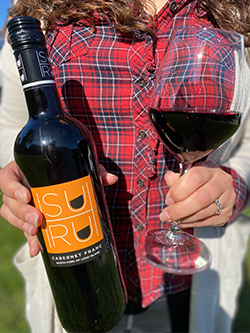 Records of Cabernet Franc go back to the end of the 18th century in Bordeaux, although it was planted in Loire long before that time. Cabernet Franc first earned its popularity in the Loire Valley in the 1700’s, at the time it was known by its original name, Bouchet. Today Cabernet Franc is planted around the globe in America, Italy, Spain, Australia, New Zealand, Argentina, Chile, Hungary, Canada, Bulgaria, Croatia, and most recently China.
Records of Cabernet Franc go back to the end of the 18th century in Bordeaux, although it was planted in Loire long before that time. Cabernet Franc first earned its popularity in the Loire Valley in the 1700’s, at the time it was known by its original name, Bouchet. Today Cabernet Franc is planted around the globe in America, Italy, Spain, Australia, New Zealand, Argentina, Chile, Hungary, Canada, Bulgaria, Croatia, and most recently China.
Fun Fact: Across the world, Cabernet Franc is one of the twenty most widely planted grape varieties.
This deeply colored, thin skinned berry offers floral, plum, blackberry, cassis, spice, fresh herbs and leafy aromas. Cabernet Franc is an excellent stand alone wine varietal producing rich, round, luscious red wines in addition to being a classic blending varietal specifically for Bordeaux style red blends.
DNA analysis indicates that Cabernet Franc is the parent of several grape varieties including Merlot and Carmenere. But perhaps its greatest claim is that it is the parent to Cabernet Sauvignon, which is the cross between Cabernet Franc and Sauvignon Blanc.
Why its Well Suited to Long Island
One of the most widely planted red grape varietals on Long Island, Cabernet Franc grows best in stone, chalk soils and sandy terroir. The North Fork of Long Island is comprised of sandy loam soils with excellent internal drainage, modest fertility, and moderate water-holding capacity which control and limit the impact of the periodic summer rains, controlling vine growth and promoting grape ripening in the fall.
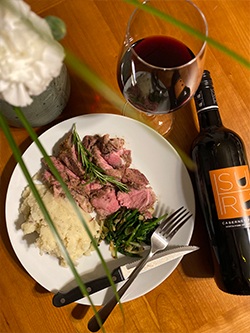 On the North Fork of Long Island our terroir is derived from our glacial soils, cool maritime climate and native flora. The soils have excellent drainage and our cool climate and proximity to the ocean means that our long summers are tempered by cooling breezes off the Long Island Sound and Atlantic Ocean that prevent excessive summer heat. The surrounding water also gives off warmth extending summer into a mellow fall, allowing ample time for the fruit to ripen on the vine. Most similar in climate to Bordeaux, France the East End has embraced "old-world" vinifera grape varieties.
On the North Fork of Long Island our terroir is derived from our glacial soils, cool maritime climate and native flora. The soils have excellent drainage and our cool climate and proximity to the ocean means that our long summers are tempered by cooling breezes off the Long Island Sound and Atlantic Ocean that prevent excessive summer heat. The surrounding water also gives off warmth extending summer into a mellow fall, allowing ample time for the fruit to ripen on the vine. Most similar in climate to Bordeaux, France the East End has embraced "old-world" vinifera grape varieties.
Suggested Food Pairings
A delicious sipper, this bold red pairs beautifully with a wide range of foods including swordfish, pork, roast chicken, grilled beef, sausage, lamb, veal, hearty fishes, hard and soft cheeses and duck.
Two particular favorites are a glass of Cabernet Franc with roasted or smoked lamb and in our opinion, no Thanksgiving dinner is complete without a bottle (or two) on the table!
How Red Wine is Made
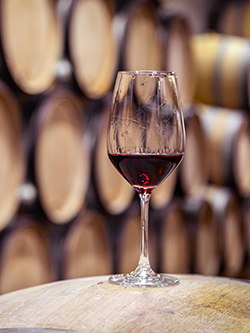 Over the last week the focus in the winery has switched over to the red harvest, so we thought we'd take a quick moment to review how red wine is made. Once our red fruit has been hand-harvested and delivered by tractor to the winery the grapes are destemmed and put through the must chiller which brings the berries to a consistent 50 degrees and agitates the berries, bursting them open. These berries, juice skins, seeds and all are pumped into open-top tanks where the magic of fermentation occurs.
Over the last week the focus in the winery has switched over to the red harvest, so we thought we'd take a quick moment to review how red wine is made. Once our red fruit has been hand-harvested and delivered by tractor to the winery the grapes are destemmed and put through the must chiller which brings the berries to a consistent 50 degrees and agitates the berries, bursting them open. These berries, juice skins, seeds and all are pumped into open-top tanks where the magic of fermentation occurs.
When the internal temperature of the tank has reached 80 degrees it is time to inoculate! The grape must (freshly crushed juice, skins, seeds, and stems) is inoculated with the winemaker's desired yeast and begins fermentation. When we talk about fermentation in wine we are referring to the chemical process of yeast cells consuming the naturally occurring sugars in the grape juice, producing alcohol and releasing carbon dioxide and heat. During the ferment as CO2 is released it rises, lifting the skins to the top of the tank.
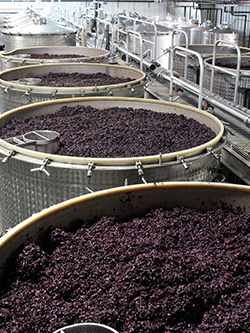 All of the tanks at the winery are temperature controlled by heating/cooling jackets that are built into the tank. These "jackets" control the internal temperature of the tank which is key during fermentation as yeast likes very specific conditions. Too warm and the yeast will overheat and die, too cold and the yeast will fall dormant and fermentation stops.
All of the tanks at the winery are temperature controlled by heating/cooling jackets that are built into the tank. These "jackets" control the internal temperature of the tank which is key during fermentation as yeast likes very specific conditions. Too warm and the yeast will overheat and die, too cold and the yeast will fall dormant and fermentation stops.
We need to ensure that the juice stays in contact with the skins throughout the fermentation process as the skins are what give red wine its color and tannin. As a result, throughout the fermentation process "punch-downs" or "pump-overs" occur regularly. At Suhru we use the punch-down method to ensure our red wines extract all of the desired color, flavor and tannin from the grape skins. Punch-downs are done mechanically by using a large mechanical foot or punch-down device which breaks up the grape skin cap that forms at the surface of the tank and reintroduces the skins into the juice. This process is done three times a day at the beginning of fermentation, gradually slowing down as the rate of fermentation slows and less and less CO2 is released. The time necessary to complete fermentation can take anywhere from 14 days up to a month depending on the healthiness of the yeast and the amount of sugar in the juice.
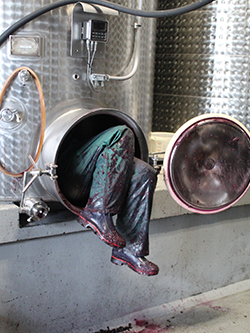 Once the fermentation process is complete and all of the sugars have been converted to alcohol the grape skins settle to the bottom of the tank and the juice is drained off and pumped into a new tank. In order to ensure we get every last drop of wine from the settled skins, the remaining grape skins are shoveled out of the tank and forklifted over to the press where we extract the remaining wine.
Once the fermentation process is complete and all of the sugars have been converted to alcohol the grape skins settle to the bottom of the tank and the juice is drained off and pumped into a new tank. In order to ensure we get every last drop of wine from the settled skins, the remaining grape skins are shoveled out of the tank and forklifted over to the press where we extract the remaining wine.
From here the wine is racked into oak barrels where it undergoes secondary fermentation or malolactic fermentation. During this second fermentation process the sharp, astringent malic acid is converted into lactic acid which gives the wine a softer, rounder mouth-feel and more pleasant drinking experience.
Once this process is complete the wine is racked into different barrels where it will stay in our temperature controlled barrel room for the next few months as it ages. Throughout the aging process the wines will be regularly checked and tested to assess a number of key components to ensure the wine is developing as expected.
Before bottling, the red wine is filtered to make sure it is clear and free of any microbial bacteria. The bottles are then aged for three to twelve months, and released once our winemaker deems them ready for consumption.
Fruit Sourcing, What it Means
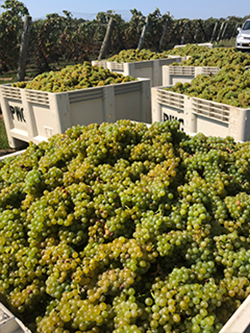
People are always surprised when we tell them that we don’t own any vineyards. One of the first questions we are asked when guests arrive at our Tasting House is "where are your vineyards" to which we respond that we source our fruit for vineyards across the North Fork of Long Island and one in the Finger Lakes.
When we started Suhru Wines in 2008 we made the decision to source, or purchase our fruit as opposed to plant our vineyards. This decision was made for a variety of reasons, two of the main factors being time and cost. As a new (at the time) winery brand it was a substantial financial and time commitment to plant and cultivate a vineyard. Vineyards can take anywhere from four to eight years to produce wine quality fruit depending on the varietals and styles you are looking to produce. Additionally, by sourcing our fruit it allows us to focus solely on quality. Sourcing fruit gives us the flexibility to work with many different vineyards, allowing us to select vineyards that each grow the particular varietals we make, the best. This ensures that we use the highest quality fruit available for each of our wines.
Fruit sourcing is a very common occurrence in the wine industry, even by wineries with estate vineyards as each region has a variety of micro-climates which influence the development of different grape varietals in very specific ways. By not limiting ourselves to one location it gives us the flexibility to adjust and adapt to the ever changing weather patterns and climate changes that we see in any given season. We also have the option of bringing on a new varietal, think Teroldego, without having to plant the vines and then wait four or more years before the vines are ready and producing fruit.
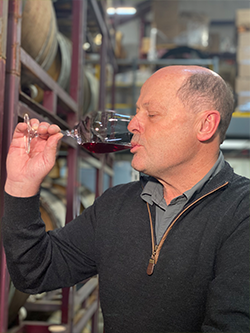 Our winemaker Russell’s more than thirty years in the industry have allowed him to make many close and meaningful relationships with the various growers we work with both on Long Island and in the Finger Lakes (where we grow our Riesling fruit). He keeps in close contact and communication with them throughout the growing season which allows us to have a lot of input on what happens in the vineyard.
Our winemaker Russell’s more than thirty years in the industry have allowed him to make many close and meaningful relationships with the various growers we work with both on Long Island and in the Finger Lakes (where we grow our Riesling fruit). He keeps in close contact and communication with them throughout the growing season which allows us to have a lot of input on what happens in the vineyard.
Russell, and our whole team at Suhru, visit the vineyards on Long Island regularly throughout the growing season to monitor the progress, yields and techniques used in the field. We know what is happening throughout the growing season and are consulted about the optimal time to pick or harvest the fruit. Therefore we have no surprises when the fruit is harvested. The only way to have more input is to grow the fruit ourselves. Although that might be an option at some point in the future, it requires a pretty large initial investment and upkeep. Growing grapes and making wine are two different skill sets. We are choosing to focus all of our attention on what we do best, making the best possible wine from the highest quality fruit!
New Release: 2019 Cabernet Franc
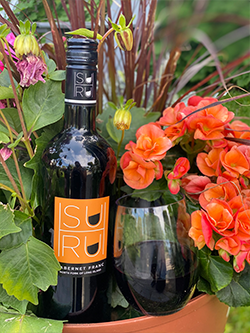 Our first Cabernet Franc under the Suhru label, we are very excited to share this much anticipated new wine! This classic expression of a cool climate Cabernet Franc has a rich garnet hue, with bright fruit and notes of black currant, raspberry, and a hint of anise on the nose. This bold red has a nice mid palate with notes of mocha and cocoa, fine lingering tannins and a light smokiness on the finish with the slightest hint of vanilla.
Our first Cabernet Franc under the Suhru label, we are very excited to share this much anticipated new wine! This classic expression of a cool climate Cabernet Franc has a rich garnet hue, with bright fruit and notes of black currant, raspberry, and a hint of anise on the nose. This bold red has a nice mid palate with notes of mocha and cocoa, fine lingering tannins and a light smokiness on the finish with the slightest hint of vanilla.
This varietal 2019 Cabernet Franc is blended with 12% Teroldego and 6% Merlot to enhance the fruit and body of the wine. The three varieties were each fermented in open top tanks and punched down during their time on skins. The goal being to extract color and tannin without the astringency, before pressing to retain the vibrant fruit notes. The wine is then aged for 14 months in a combination of Hungarian and French oak.
In 2019 we saw a very nice growing season and were very happy with the fruit intensity and ripe tannin structure of this wine. Cabernet Franc grows beautifully on the North Fork of Long Island and the 2019 harvest was no exception. In the last several years we have seen this varietal continue to receive critical acclaim and rightly so. Russell, our winemaker, has seen dramatic changes to the perception of Cabernet Franc during his winemaking career. He made his first stand alone varietal Cabernet Franc at Pellegrini Vineyards in 1994 from vines that were originally planted to be used for blending rather than for a stand alone varietal wine. Since then Cabernet Franc has grown to be a staple of Long Island. Russell (and the whole Suhru family) are very happy to share Suhru’s first vintage of Cabernet Franc (and his 26th vintage of Cab Franc as a Long Island winemaker). We hope you enjoy it!
This beautiful, bold red will pair wonderfully with rich, fuller meals such as roasted pork, turkey, stews, tomato based sauces, lamb, and roasted duck. An excellent cheese wine, try with brie, goat and bleu cheeses!
Learn More About our 2019 Cabernet Franc!
Wine of the Month: 2019 Shiraz
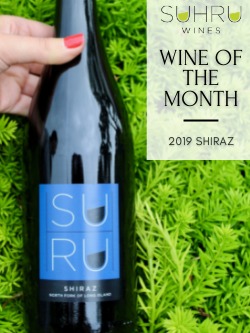 With Labor Day upon us and a cool Fall chill creeping into the air we find ourselves trading in a chilled glass of white for a richer, deeper red. One of our favorite Fall wines is Shiraz! This beautiful light to medium bodied red has nice soft flavors with a hint of spice which bring to mind cool days traipsing through a pumpkin patch, and sweater weather!
With Labor Day upon us and a cool Fall chill creeping into the air we find ourselves trading in a chilled glass of white for a richer, deeper red. One of our favorite Fall wines is Shiraz! This beautiful light to medium bodied red has nice soft flavors with a hint of spice which bring to mind cool days traipsing through a pumpkin patch, and sweater weather!
Whether you are looking for a wine to enjoy after a long day at work, a glass to pair with a fall meal complete with richer meats and fall vegetables, or simply a wine to enjoy while watching the leaves change, a bottle of Shiraz is always a great choice!
Shiraz vs Syrah, What's the Difference?
At Suhru Wines we make a Shiraz as opposed to a Syrah. Two different styles of the same grape variety, generally speaking Syrah is made in the Northern hemisphere, specifically France’s Rhône Valley, whereas you tend to find winemaking regions producing Shiraz style wines in the Southern hemisphere, mainly in Australia. Given that our winemaker, Russell Hearn, is Australian we are making a Shiraz here at Suhru!
Shirazes are known for being rich, lush, riper, and more fruit-forward wines that are typically made in warm climates, although they are made in several cool climates across the globe, including the Margaret River Region in Western Australia as well as the North Fork of Long Island. Cool climate Shirazes and Syrahs tend to have brighter acidity and bright red fruit notes.
A Closer Look at Suhru Shiraz
A rarity in the United States, our cool climate Shiraz pays homage to winemaker Russell Hearn's native country Australia. This expressive wine has rich red fruit aromas with a hint of cardamom. The raspberry and cherry notes flow onto the palate with appealing cola flavors carrying through to the finish. With super soft, elegant tannins, a bright finish, and a light hint of oak, the 2019 is sure to please! Fermented in open top tanks, our 2019 Shiraz juice spent 10-12 days in contact with the grape skins before being pressed, allowing for the bold flavor and rich color. The wine was then transferred into barrel where it is aged for 6 months in American oak. The 2019 vintage is 93% Syrah and 7 % Teroldego.
